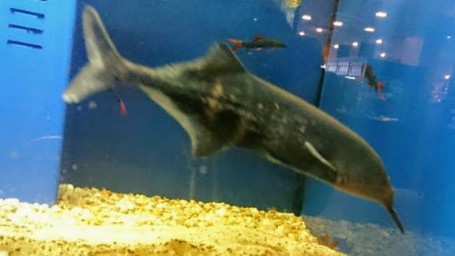- Name:
Elephant Nose
(View AKA's) - Family: Mormyridae
- Species: Gnathonemus
- Scientific Name: Gnathonemus petersii


More Details
General info about Elephant Nose
The Elephant Nose, scientific name Gnathonemus petersii, is a freshwater fish that is native to the rivers and streams of West and Central Africa. They are also known as the Peters' Elephant Nose or the Long-Nosed Elephant Fish.
The Elephant Nose is a unique looking fish with an elongated, narrow body and a long, thin snout that is used to detect prey in the murky waters of their natural habitat. They can grow up to 10 inches in length and are typically black or brown in color with a silver underside.
Elephant Nose Diet & Nutrition
In the wild, Elephant Nose fish are primarily carnivorous and feed on small fish, insects, and crustaceans. In captivity, they can be fed a diet of live or frozen bloodworms, brine shrimp, and other small aquatic invertebrates. They can also be fed small pieces of fish or shrimp.
Determining Sex of Elephant Nose
It can be difficult to determine the sex of Elephant Nose fish as they do not display any external differences between males and females. However, females tend to be larger and more rounded than males.
Breeding & Spawning Elephant Nose
Breeding Elephant Nose fish in captivity can be challenging. They are typically solitary fish and do not form pair bonds. In order to encourage breeding, it is recommended to keep a small group of fish together and provide them with plenty of hiding places such as caves or plants. The water temperature should be kept between 78-82°F and the pH should be slightly acidic. They are egg scatterers and the eggs will be scattered throughout the tank. The eggs will hatch in 4-5 days and the fry will be free-swimming after another 3-4 days.
Common Diseases with Elephant Nose
The Elephant Nose fish is generally hardy and not prone to many diseases if kept in a clean and well-maintained aquarium. However, they can be susceptible to parasitic infections and bacterial infections if water conditions are not optimal.
Elephant Nose Origin
The Elephant Nose fish is native to the rivers and streams of West and Central Africa, including the Congo River Basin and the Niger River Basin.
Caution with Elephant Nose
The Elephant Nose fish is generally a peaceful fish and can be kept with other non-aggressive species. However, they are sensitive to changes in water conditions and can be stressed by aggressive or territorial tank mates. They also require a lot of swimming space and should be kept in a tank with plenty of hiding places and open swimming areas.
Acclimating Elephant Nose
When introducing Elephant Nose fish to a new aquarium, it is important to acclimate them slowly to prevent stress and shock. This can be done by floating the bag of fish in the aquarium for 15-20 minutes to allow the water temperature to equalize, then gradually adding small amounts of aquarium water to the bag over a period of 1-2 hours. Once the fish have been acclimated, they can be released into the aquarium.
Original Detail
| Name | Species | Family | Scientific Name | More Detail | Added by |
|---|---|---|---|---|---|
| Elephant Nose | Gnathonemus | Mormyridae | Gnathonemus petersii | The Elephant Nose, scientific name Gnathonemus petersii, is a freshwater fish that is native to the rivers and streams of West and Central Africa. They are also known as the Peters' Elephant Nose or the Long-Nosed Elephant Fish. The Elephant Nose is a unique looking fish with an elongated, narrow body and a long, thin snout that is used to detect prey in the murky waters of their natural habitat. They can grow up to 10 inches in length and are typically black or brown in color with a silver underside. | PalaciosAn |
Changed by users
| Submitted Date | Submitted By | Status | Action |
|---|

